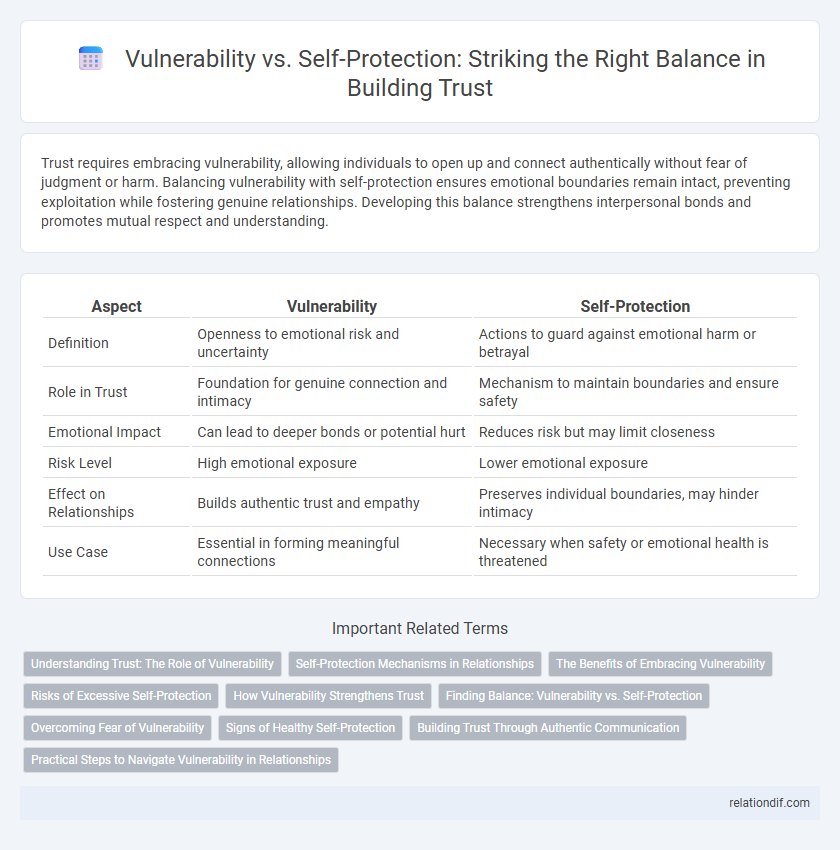Trust requires embracing vulnerability, allowing individuals to open up and connect authentically without fear of judgment or harm. Balancing vulnerability with self-protection ensures emotional boundaries remain intact, preventing exploitation while fostering genuine relationships. Developing this balance strengthens interpersonal bonds and promotes mutual respect and understanding.
Table of Comparison
| Aspect | Vulnerability | Self-Protection |
|---|---|---|
| Definition | Openness to emotional risk and uncertainty | Actions to guard against emotional harm or betrayal |
| Role in Trust | Foundation for genuine connection and intimacy | Mechanism to maintain boundaries and ensure safety |
| Emotional Impact | Can lead to deeper bonds or potential hurt | Reduces risk but may limit closeness |
| Risk Level | High emotional exposure | Lower emotional exposure |
| Effect on Relationships | Builds authentic trust and empathy | Preserves individual boundaries, may hinder intimacy |
| Use Case | Essential in forming meaningful connections | Necessary when safety or emotional health is threatened |
Understanding Trust: The Role of Vulnerability
Vulnerability plays a crucial role in building trust, as it allows individuals to openly share their true feelings and experiences without fear of judgment, creating emotional intimacy and deeper connections. Self-protection mechanisms, while important for personal boundaries, can inhibit trust development by fostering guardedness and limiting authentic communication. Understanding this balance helps individuals foster stronger relationships through intentional vulnerability paired with appropriate self-awareness.
Self-Protection Mechanisms in Relationships
Self-protection mechanisms in relationships often manifest as emotional walls or withdrawal, hindering genuine connection and trust-building. These defense strategies are triggered by past experiences of betrayal or hurt, prompting individuals to prioritize personal safety over intimacy. Understanding and addressing these mechanisms allows partners to foster vulnerability and create a foundation of mutual trust.
The Benefits of Embracing Vulnerability
Embracing vulnerability fosters deeper trust by encouraging authentic connections and open communication, which strengthens relationships both personally and professionally. Vulnerability allows individuals to express genuine emotions and admit uncertainties, creating a foundation of honesty that enhances mutual understanding and collaboration. This openness reduces defensive barriers, promoting resilience and emotional intelligence that drive long-term relational growth.
Risks of Excessive Self-Protection
Excessive self-protection can significantly undermine trust by creating emotional barriers that hinder authentic connection and open communication. This over-guarding often leads to misunderstandings and isolation, preventing the establishment of genuine relationships essential for collaboration and support. Balancing vulnerability with appropriate boundaries is crucial to minimizing risks such as emotional detachment and decreased interpersonal trust.
How Vulnerability Strengthens Trust
Vulnerability fosters trust by encouraging openness and authenticity, allowing individuals to connect on a deeper emotional level. Demonstrating vulnerability signals confidence and honesty, which reduces barriers and builds mutual understanding. This emotional transparency enhances relational bonds, making trust more resilient against misunderstandings and conflicts.
Finding Balance: Vulnerability vs. Self-Protection
Finding balance between vulnerability and self-protection is crucial for building authentic trust in relationships. Embracing vulnerability allows for deeper emotional connections and fosters empathy, while practicing self-protection ensures personal boundaries are maintained to prevent emotional harm. Effective trust cultivation depends on recognizing when to open up and when to safeguard one's emotional well-being.
Overcoming Fear of Vulnerability
Overcoming the fear of vulnerability is essential for building genuine trust in relationships, as it allows individuals to authentically connect and share their true thoughts and emotions. Embracing vulnerability encourages openness and reduces the need for self-protection, fostering deeper understanding and emotional safety. Developing resilience and self-compassion helps to confront fears and create a foundation of mutual trust and acceptance.
Signs of Healthy Self-Protection
Healthy self-protection manifests as clear personal boundaries, the ability to communicate needs assertively, and maintaining emotional resilience without shutting down or avoiding connection. Recognizing and respecting one's limits while remaining open to vulnerability fosters authentic trust in relationships. Consistent self-awareness and emotional regulation are key indicators that self-protection supports growth rather than defense mechanisms.
Building Trust Through Authentic Communication
Authentic communication fosters trust by encouraging vulnerability that deepens connections and reduces reliance on self-protection mechanisms. Transparent expressions of feelings and intentions create an environment where honesty thrives, allowing relationships to strengthen through mutual understanding. Embracing vulnerability as a strength enables trust to grow organically, promoting openness and emotional safety.
Practical Steps to Navigate Vulnerability in Relationships
Embracing vulnerability in relationships fosters deeper trust by encouraging open communication and emotional honesty. Practical steps include setting clear personal boundaries, actively listening, and expressing feelings without fear of judgment. Balancing self-protection involves recognizing emotional limits while allowing space for genuine connection and empathy.
Vulnerability vs self-protection Infographic

 relationdif.com
relationdif.com